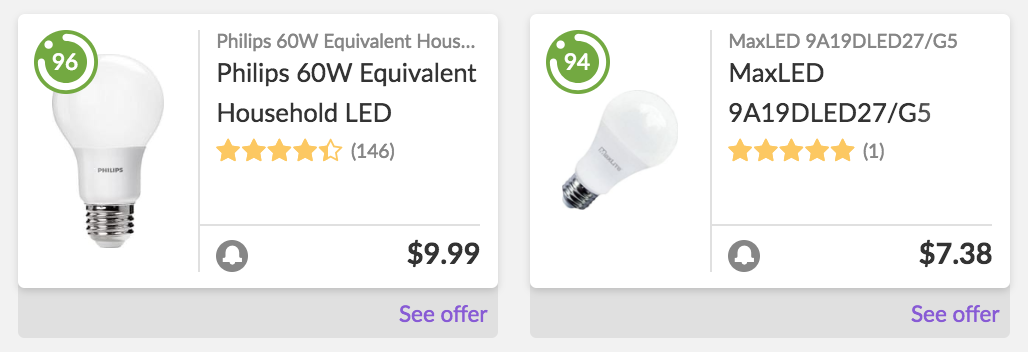According to a new study by Opinion Dynamics [1], mass market incentive-based energy efficient lighting programs, such as the current upstream residential lighting programs administered by the California IOUs, are achieving diminishing returns.
Why? Because the California lighting market is nearing transformation. According to the report:
- Only 1% of Californians have not heard of CFLs and only 5% have not heard of LEDs;
- LEDs already dominate the lighting market, representing an estimated 74% of standard bulb sales and 82% of reflector bulbs sales at current prices;
- Even though LEDs are more expensive, demand for LEDs is not price elastic, which is likely a function of strong preference for the technology.
Offering mass market financial incentives under these circumstances means wasted ratepayer dollars, as many people would have purchased efficient LEDs without incentives.
So is the work of utilities done? Not quite.
For one thing, not all LEDs (and certainly not all CFLs) are created equal. Even among LEDs, there is a wide range in energy efficiency. Take 60W-equivalent A19 LED bulbs – the most common type – as an example:
Enervee data show that the most efficient models currently on the market provide upwards of 65% more light (lumens) per unit of electric power input (Watt) than the least efficient. And the higher efficacy comes without incremental cost.
Making Efficiency Visible, Driving More Efficient LED Purchases
So there is a critical role for utilities to play in making efficiency visible to consumers and nudging them towards more efficient LED model choices, without incentives.
In fact, California utilities are already doing so, by providing their customers with online energy management technology marketplaces, as mandated by the Public Utilities Commission. These consumer-facing choice engines make it simple and compelling to shop energy smart – with a zero to 100 energy efficiency index, personalized total cost of ownership, product reviews, and the best retail prices [2].

According to an independent assessment of the PG&E Marketplace by Research Into Action [3], the PG&E Marketplace was influential in 58% of light bulb purchasing decisions (extremely influential in 31%).
Despite a general preference for LEDs, not all customers have an easy time finding the products that fit their needs; only 28% of Californians find it very easy to locate and select the correct lighting product [1]. Utility marketplaces can reduce friction in the shopping journey and have therefore been given high marks by consumers [3].
The key marketplace features valued by shoppers are energy-related features not available elsewhere, in particular the Enervee Score (found helpful or extremely helpful by 78% of shoppers), integrated incentives, personalized energy bill savings, and cost to buy and operate the model (total cost of ownership).
As a result, the PG&E Marketplace nudged efficient bulb purchases during the 34-month trial period that will save 6,000 MWh on a gross lifetime basis [4]. Seventy-one percent of influenced purchases were to replace an existing bulb before it failed. This included influencing purchases that benefitted from upstream incentives, as well as purchases that did not, another indication that market-based approaches can succeed, without the need for mass market incentives.
Targeting Underserved Customers
The second area where utility engagement is still needed is to address customer segments that lag behind in their adoption of energy efficiency lighting products.
According to Opinion Dynamics, renters and customers residing in multifamily properties are disproportionately more likely than homeowners and customers residing in single-family properties to have heard of LEDs but not used them. And renters and lower income customers have lower LED saturation rates.
Thus Opinion Dynamics recommended that IOUs continue targeting underserved customer groups with incentives in the short-term. In addition to in-store approaches, this strategy can be delivered online through the utility marketplaces, with the added benefit of providing the “Frugal Consumer” segment with information on where to get the best prices on LEDs across retailers and their total cost of ownership, which is particularly important when considering LEDs vs. shorter-lived technologies like CFLs and incandescents.
Recognizing that for the Frugal Consumer – for whom “upfront cost is everything” – traditional rebates do not address this barrier, Enervee’s utility clients now have the option of providing instant online incentives to income-constrained households, through our partnerships with online retailers, addressing the up-front incremental cost barrier.
Finally, Opinion Dynamics recommended investing in ensuring compliance with standards, including the compliance of online lighting retailers. Enervee has the capability to check whether products featured on California utility marketplaces have been duly registered with the California Energy Commission, supporting efforts to encourage compliance.
The current state of the California lighting market illustrates why program strategies and tactics need to evolve along the technology adoption curve, and why regulators should create the conditions to allow – and actively encourage – utilities to shift residential lighting budgets from mass market incentives to innovative market transformation & behavioral approaches, coupled with much more targeted incentives. California’s online utility marketplaces can be readily leveraged to implement the recommendations made and capture additional savings.
Notes
[1] Draft final report at pda.energydataweb.com/#/documents/2035/view
[2] Visit the light bulb listings on the PG&E and SCE and energy management technology marketplaces.
[3] etcc-ca.com/reports/assessment-pge%E2%80%99s-online-marketplace
[4] This estimate is very conservative, as it assumed that the lifetime of the LED purchases influenced was only 8 years, when many LEDs now have rated lifetimes of 20 years or more.
